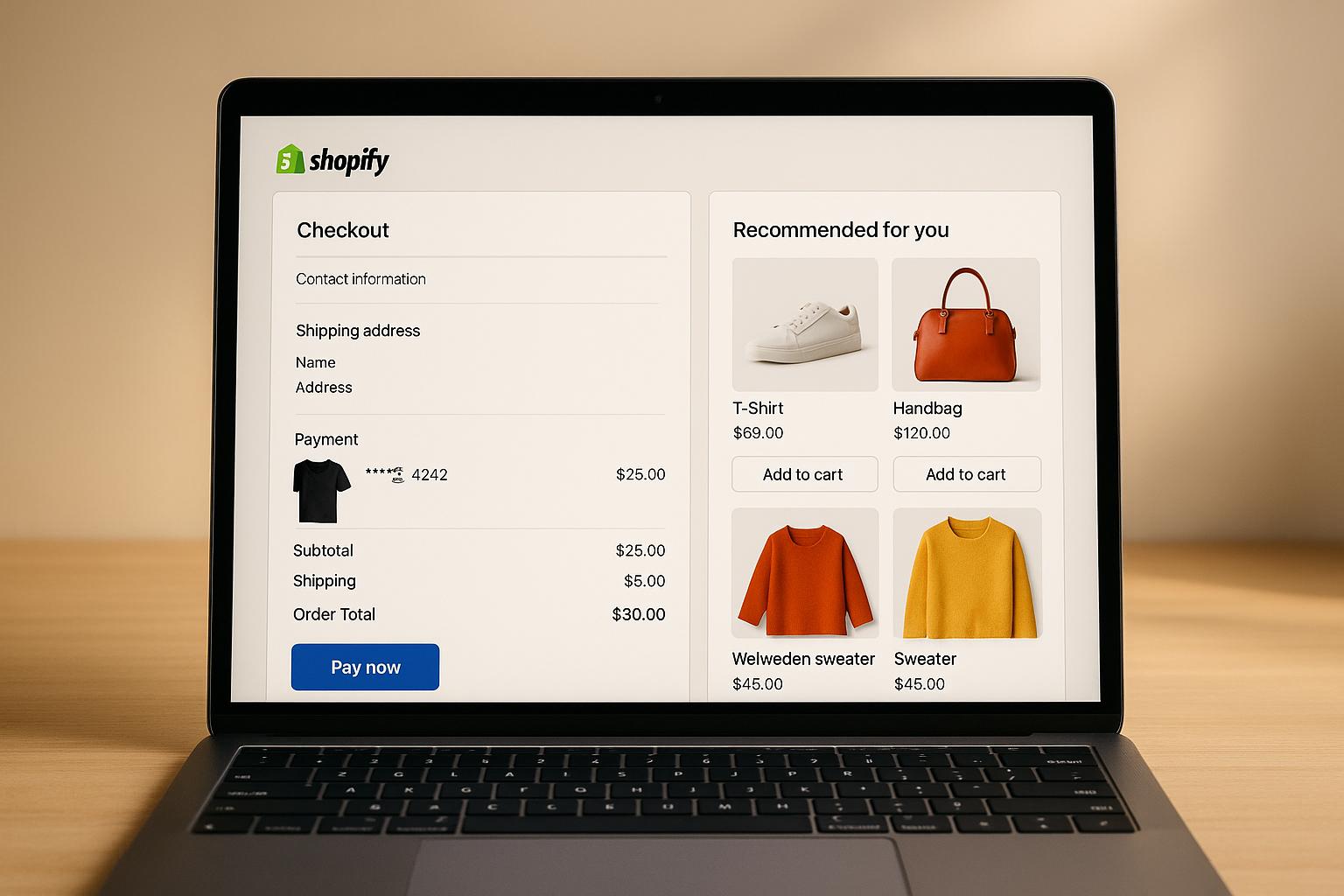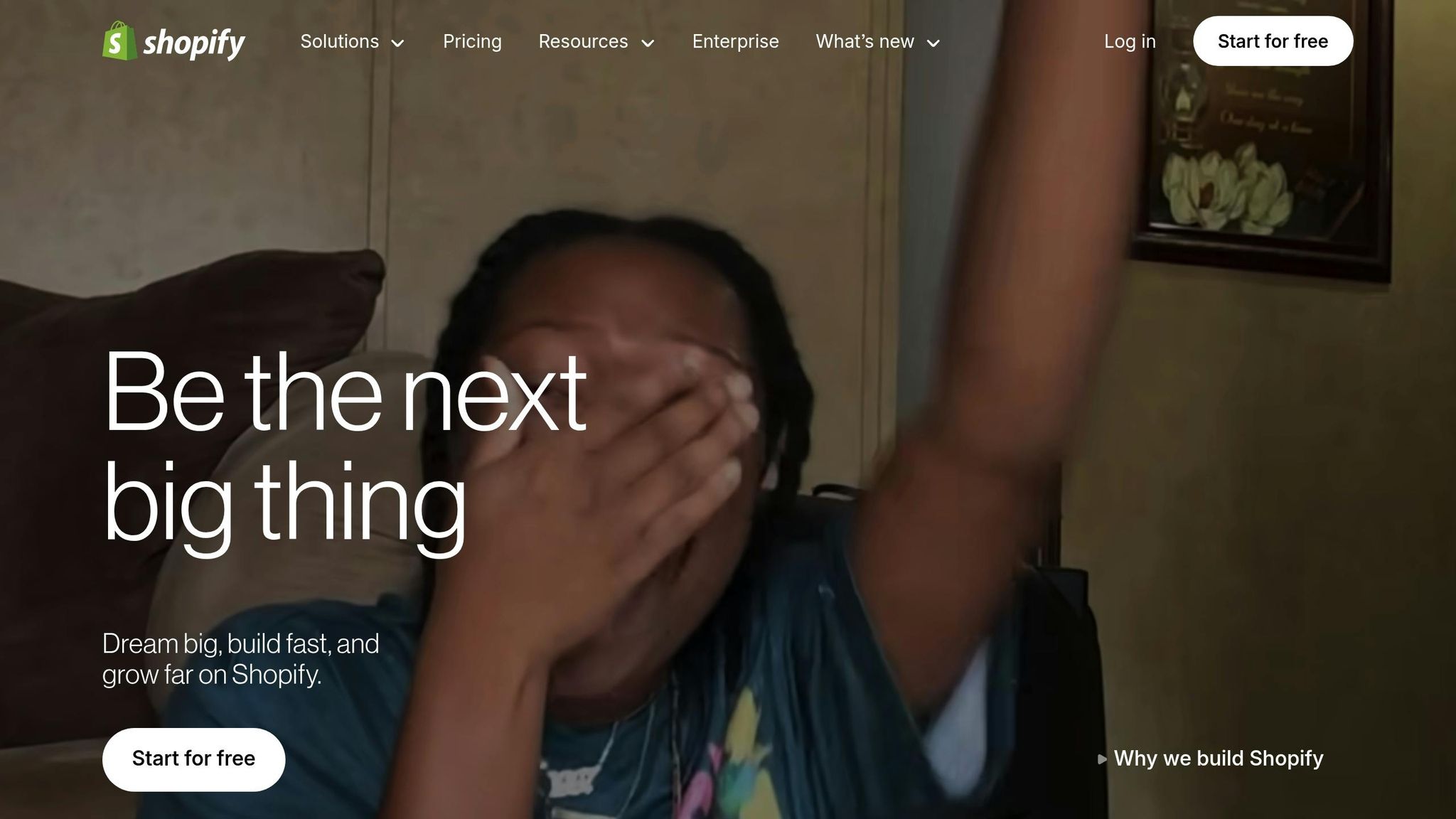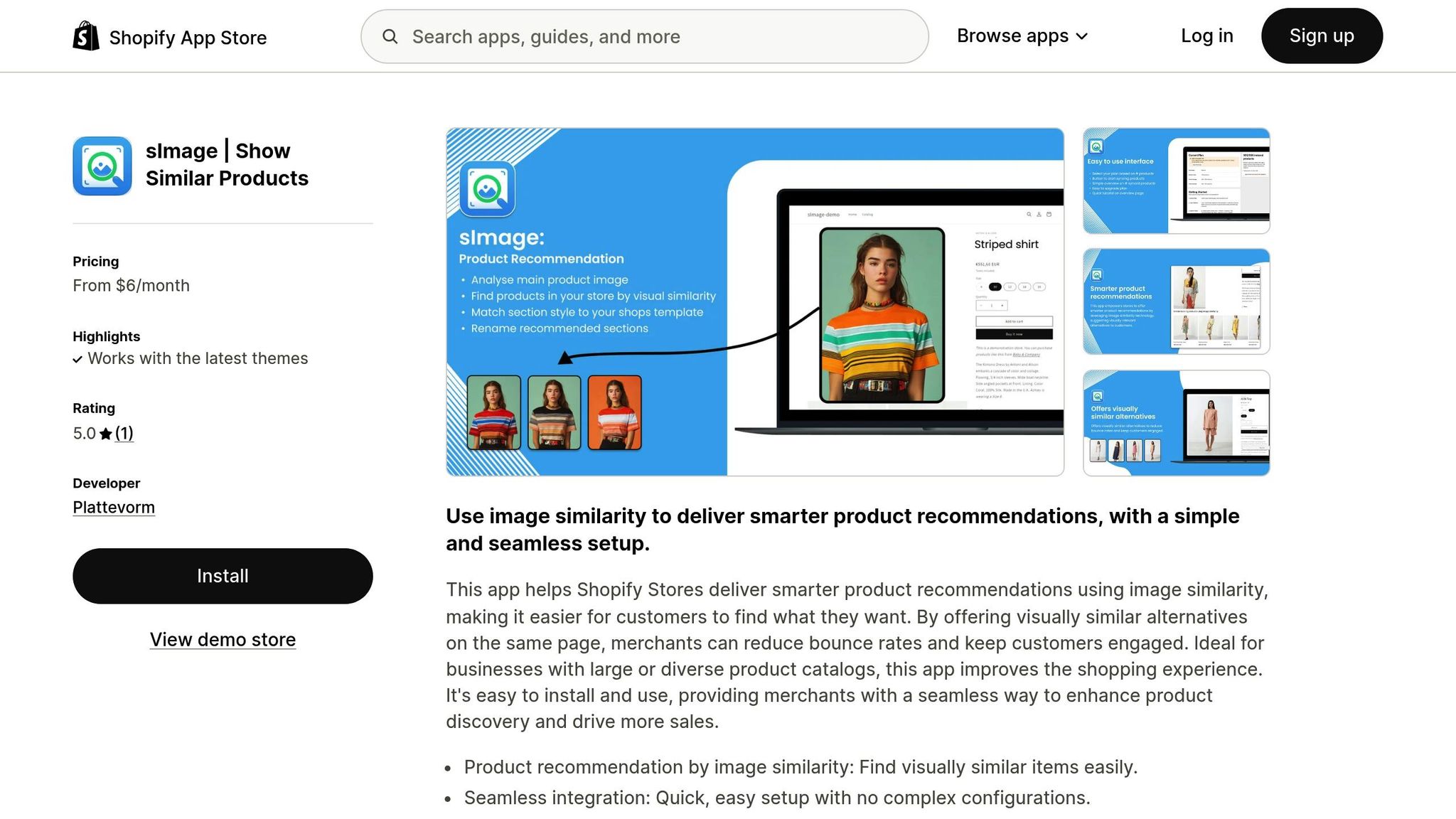How AI Boosts Average Order Value on Shopify

How AI Boosts Average Order Value on Shopify
AI tools are helping Shopify merchants increase Average Order Value (AOV) by making product recommendations smarter and more personalized. Here's the main takeaway: AI-driven cross-selling leverages visual product analysis, real-time customer behavior tracking, and purchase history to suggest items that align with shopper preferences. This approach not only boosts revenue but also improves the shopping experience.
Key Highlights:
- What is AOV?: Average Order Value measures how much a customer spends per transaction. Increasing AOV directly impacts revenue without requiring new customers.
- How AI Helps: AI tools like sImage use image recognition and behavior analysis to recommend complementary or similar products.
- Proven Results: Shopify merchants report higher AOV, better conversion rates, and increased customer satisfaction after adopting AI-powered tools.
- Techniques Used:
- Visual Analysis: Matches products based on color, texture, and style.
- Behavioral Tracking: Adapts suggestions based on real-time browsing habits.
- Personalized Upselling: Recommends items tailored to customer preferences and purchase history.
- Industries Seeing Growth: Fashion, electronics, and home goods benefit the most.
AI tools like sImage are easy to integrate with Shopify and show measurable improvements quickly, especially during high-traffic periods like Black Friday. By refining cross-selling strategies, merchants can grow revenue and improve the shopping experience.
Research Shows AI Cross-Selling Increases Revenue
Measured AOV Growth with AI Tools
Research highlights how AI-powered recommendation tools can drive higher average order value (AOV) on Shopify. These improvements often become evident just weeks after implementation.
Industries like fashion, electronics, and home goods have seen clear gains by aligning product recommendations with shopper preferences. For example, fashion retailers report strong AOV growth when using visual similarity tools to suggest items that match a shopper's style. In electronics and home goods, pairing complementary products - like smartphone cases with phones - has proven effective in boosting AOV.
During high-traffic times, such as Black Friday or the holiday season, AI-driven recommendations help maintain these AOV increases. Beyond the numbers, these tools also contribute to better conversion rates and enhanced customer satisfaction.
Higher Conversion Rates and Customer Satisfaction
AI cross-selling doesn’t just boost revenue - it also improves other critical metrics like conversion rates. When product recommendations align with a shopper's browsing habits and visual preferences, the likelihood of purchase increases.
This effect ties back to customer psychology. When shoppers are presented with items that truly complement their interests, they’re more likely to add those items to their cart. AI makes this possible by analyzing product attributes like color, style, and material to deliver highly relevant suggestions.
Stores also benefit from fewer returns when customers are offered better-matched products. Additionally, the time shoppers spend on product pages often increases, signaling that the recommendations are both engaging and relevant.
Before and After Results from Shopify Merchants

Shopify merchants provide real-world examples of how AI tools improve performance. Many report noticeable boosts in customer engagement and purchasing behavior after adopting visual AI tools like sImage.
Before using tools like sImage, manual cross-selling often fell short of connecting with customers. After implementation, merchants observed higher engagement and add-to-cart rates, leading to sustained AOV growth. The seamless integration with Shopify makes these tools easy to adopt and scale.
Some merchants have even seen significant increases in monthly revenue, proving that AI-powered cross-selling can deliver results for businesses of all sizes. By combining visual product matching with insights from customer behavior, merchants achieve lasting improvements in both revenue and customer experience.
[Boost Shopify Sales] - AI Generated Bundle Offers
AI Methods That Improve Cross-Selling Results
These AI-driven techniques are sharpening cross-selling strategies on Shopify, helping businesses unlock new revenue opportunities.
AI Image Analysis for Similar Product Suggestions
Visual similarity analysis is a game-changer for cross-selling on Shopify. This approach uses AI to study product images, analyzing features like color, texture, shape, and style. It then matches those features to similar items in the store's catalog.
For instance, sImage employs advanced AI to detect visual patterns. Say a customer is eyeing a red leather handbag - this tool identifies other products with similar colors, materials, or design elements, making cross-selling feel natural and relevant.
This method shines in industries like fashion, home décor, or any business with visually rich catalogs. Unlike traditional recommendation systems that rely on purchase history or category matching, image analysis taps into aesthetic preferences, which often play a key role in buying decisions.
What sets this apart is its ability to surface items customers might not stumble upon otherwise. For example, someone browsing a specific dress might be shown matching accessories like scarves or shoes that complete the look. Beyond visuals, the AI also factors in real-time shopping behavior to fine-tune its suggestions, ensuring recommendations are both timely and appealing.
Customer Behavior Analysis and Real-Time Recommendations
AI takes cross-selling further by analyzing real-time customer behavior to generate dynamic product suggestions. It doesn't stop at static recommendations; instead, it adapts based on how customers interact with the site during their session.
The system tracks behaviors such as browsing time, scrolling patterns, clicks, and cart activity. By monitoring these actions, it builds a profile to predict what might catch a shopper's eye next. For instance, if someone starts by exploring casual wear but later shifts to formal attire, the AI adjusts its recommendations to reflect this change in interest.
Timing also plays a role. During specific seasons or promotional periods, the AI prioritizes suggestions that align with current trends. For example, back-to-school season might prompt recommendations for educational supplies, even if a customer hasn’t specifically searched for them. While real-time data adapts suggestions on the fly, historical data allows for even more precise upselling strategies over time.
Custom Upselling and Cross-Selling Based on Customer Data
Personalized engines take upselling and cross-selling to the next level by leveraging customer data - like purchase history, browsing habits, and demographics - to tailor recommendations.
By combining these data points, the system can suggest products that align with a shopper's preferences. For example, someone who frequently buys organic skincare might see recommendations for complementary organic products. Similarly, a customer who regularly purchases tech accessories could be shown the latest gadgets or related items.
Predictive modeling plays a big role here. If a customer tends to buy running shoes every six months, the AI might recommend new athletic gear or accessories just as their replacement cycle approaches.
Price sensitivity is another factor. Shoppers who usually go for premium products might see upselling suggestions for higher-end options, while those who lean toward budget-friendly choices are shown cross-selling ideas that add value without significantly increasing the total cost.
Thanks to Shopify’s integration with customer data, these AI systems continuously refine their profiles. The more a customer interacts with the store, the smarter and more relevant the recommendations become. This personalized approach not only increases average order value (AOV) but also strengthens customer loyalty, complementing the visual and behavior-based methods described above.
sbb-itb-521eef9
Case Studies: AI Tools Increase Shopify Store Revenue
Real-world examples highlight how AI-driven visual product recommendations can significantly boost the average order value (AOV) for Shopify merchants.
sImage: Boosting AOV Through Visual Product Recommendations

sImage showcases the power of AI image analysis in enhancing cross-selling strategies on Shopify. By leveraging computer vision, this tool examines product images and suggests visually similar items from the store's catalog. This helps shoppers find products that align with their style preferences. For example, if a customer is browsing a navy blue sweater, sImage might recommend matching pants or accessories with complementary colors and designs.
What sets sImage apart from traditional recommendation systems is its ability to focus on visual cues rather than just purchase history or product categories. This intuitive approach feels natural to shoppers and enhances their browsing experience. The app integrates effortlessly with Shopify, automatically analyzing the store's catalog and displaying visually relevant suggestions as customers navigate the site.
Key Features of AI Cross-Selling Tools
AI cross-selling tools like sImage come with several advantages for Shopify merchants:
- No-code setup: This eliminates technical hurdles, making the tool accessible for businesses of all sizes.
- Seamless integration: The recommendation widgets blend smoothly with the store's existing design, maintaining a consistent user experience.
- Scalability: Whether you're a small boutique or a larger retailer, sImage can adapt to your store's needs.
By analyzing visual similarities within the store's catalog, sImage simplifies the discovery process, encouraging customers to add complementary items to their carts without disrupting their shopping flow.
Merchant Results and Performance Insights
Shopify merchants using AI-powered visual recommendation tools have reported noticeable improvements in key metrics, especially in AOV. Many store owners observe that customers are more likely to add related items during their shopping journey, leading to increased engagement and higher overall sales.
These tools not only enhance customer interaction but also deliver immediate results. The ease of implementation combined with measurable performance gains makes AI-driven visual recommendations an attractive option for Shopify merchants aiming to grow their revenue. This success highlights the transformative potential of AI in shaping the future of e-commerce.
Conclusion: Growing AOV with AI on Shopify
Research highlights how AI-powered cross-selling tools are transforming revenue growth for Shopify merchants. The data clearly shows that when visual recommendation systems are effectively implemented, they improve both customer experiences and business outcomes.
Building on the research and case studies discussed, here’s a closer look at the benefits and future possibilities for AI-driven cross-selling on Shopify.
Key Benefits from Research and Case Studies
AI-driven cross-selling delivers tangible results, including higher average order values (AOV) by encouraging customers to add complementary products to their carts.
Improved customer satisfaction plays a big role here. When shoppers are presented with products that match their tastes and preferences, they feel more confident about their purchases, leading to longer engagement and better conversion rates.
Tools like sImage stand out with their no-code setup and smooth integration, making it easy for even small businesses to adopt AI solutions and see quick revenue growth.
Future AI Trends for Product Recommendations
AI technology is evolving rapidly, and Shopify merchants can expect even more advanced features in the near future. For instance, computer vision algorithms are improving, enabling a deeper understanding of product aesthetics - like texture, style, and seasonal relevance. This means future recommendation systems will identify subtle visual connections that current tools might overlook.
Another exciting trend is real-time personalization. As AI systems get better at processing customer behavior instantly, recommendations will adjust dynamically. Factors like browsing habits, time of day, weather, or trending styles will influence suggestions, making cross-selling feel more tailored and timely.
The integration of predictive analytics with visual recommendation tools is also on the horizon. By combining image recognition with models that predict purchasing behavior, AI could anticipate customer needs before they’re even expressed, offering complementary products at just the right moment in the shopping journey.
These advancements suggest a future where AI-powered cross-selling becomes more refined while remaining accessible to businesses of all sizes. Tools like sImage are laying the groundwork, helping Shopify stores steadily increase their average order value as AI technology continues to improve.
FAQs
How does AI-powered image analysis improve cross-selling on Shopify compared to traditional recommendation systems?
AI-driven image analysis takes cross-selling to a new level by using visual data to recommend products that match or complement what a shopper is currently viewing. Instead of relying solely on purchase history or browsing patterns, this method focuses on the visual appeal of items, delivering suggestions that feel more natural and tailored.
By examining product images, AI identifies visual elements like color, style, and patterns to suggest items that align with a shopper's tastes. This approach not only makes the shopping journey more enjoyable but also encourages deeper engagement and increases the chances of additional purchases - helping to boost the average order value.
How can AI-driven product recommendations help Shopify stores increase average order value (AOV) during busy shopping events like Black Friday?
AI-driven product recommendations can play a big role in increasing average order value (AOV) during busy shopping events like Black Friday. By analyzing a shopper’s browsing habits, AI can suggest complementary items that make sense together - like matching gloves or a scarf to go with a winter jacket. These tailored suggestions encourage customers to add more to their carts.
Another smart approach involves creating dynamic product bundles based on what customers are likely to want. For instance, offering deals like "Buy 3, Save 20%" can make purchases feel more rewarding. These personalized bundles not only make the shopping experience smoother but also encourage bigger checkouts. With visually engaging and relevant recommendations, AI helps Shopify stores make the most of peak shopping seasons.
How can small Shopify store owners use AI tools like sImage to grow their business without technical skills?
Small Shopify store owners can tap into AI tools like sImage to grow their business, no tech skills required. These tools are built to be simple and intuitive, so anyone can get started without needing to write a single line of code.
With features like automated visually similar product recommendations, sImage takes the guesswork out of cross-selling. It helps merchants showcase related products to customers, making it easier to boost average order value. Plus, it enhances the shopping experience, creating a win-win for both store owners and their customers - all without the need for a technical background.